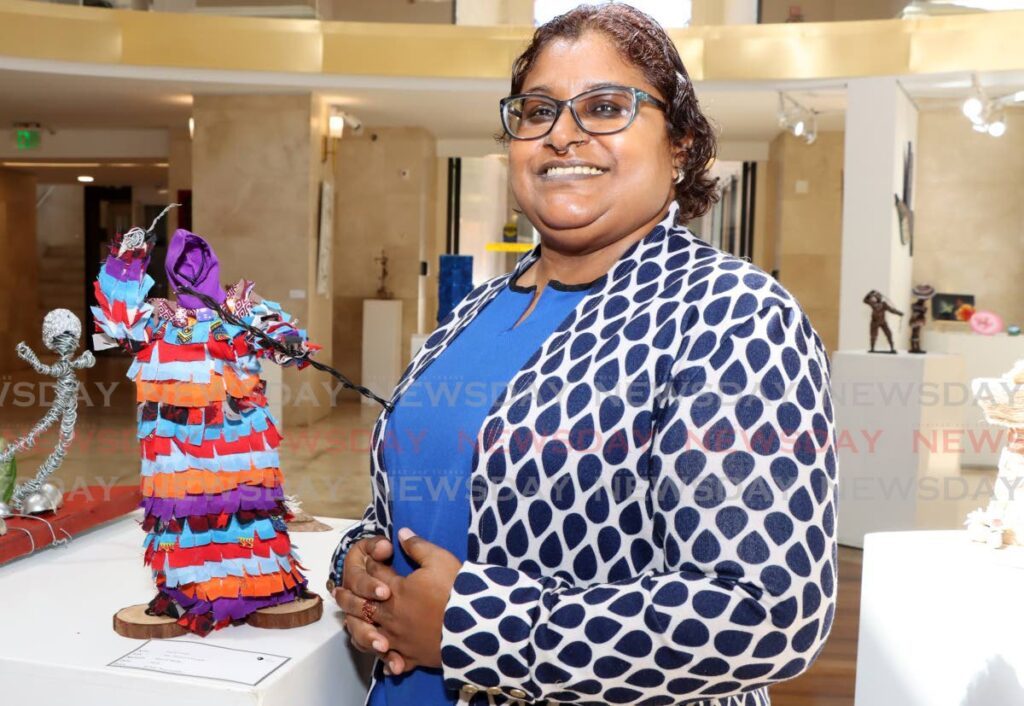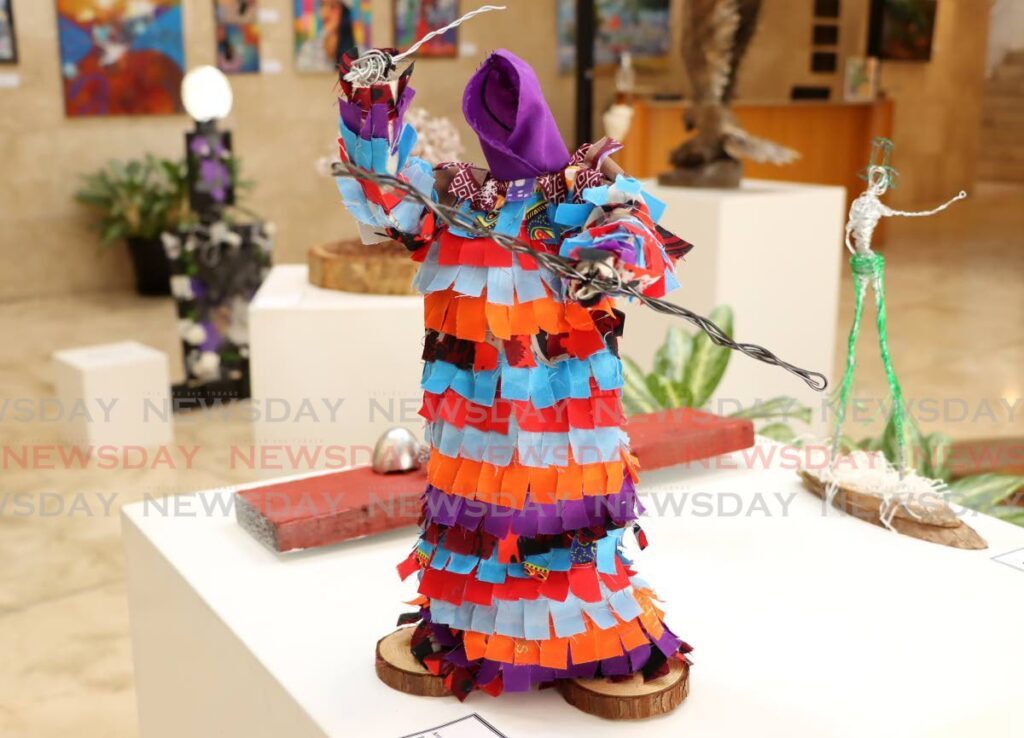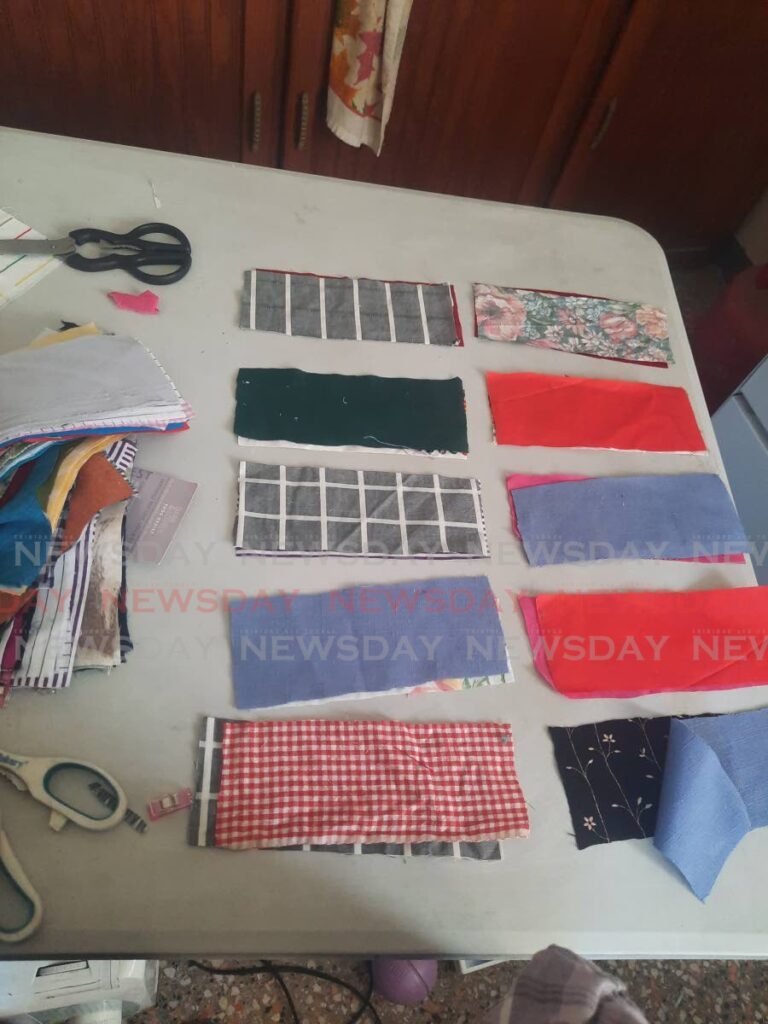The making of a pierrot grenade

When some people hear the name pierrot grenade, their first thought is the spelling of words in a humorous manner.
But as someone who sews, I’ve always been intrigued by how the costume is put together – something I got to do in 2023 and 2024 through an interesting combination of circumstances and my links with an ole mas band.
Since 2017, I’ve been part of a band led by Cherisse Lauren Berkeley who comes from a famous family of mas-makers, including her uncle Wayne Berkeley. Previously, the band competed during the Bocas Lit Fest Ole Mas Competition with various themes and presentations. This year, the second in which she brought out a mas band, she asked me to be a pierrot grenade. Last year, I played an imp.
Research
I began doing research into the character using websites and resources from the UWI Department of Creative and Festival Arts and UWI-Roytec. I learned that the original pierrot came from France with the colonisers, was finely dressed in silks and proud of his ability with words. The National Carnival Commission’s (NCC) website says the character is “the supreme jester in Trinidad Carnival...and delights in displaying his knowledge and ability to spell any word.” They also used to have a whip or bull pestle to fight other pierrots.
In Trinidad, the freed slaves were not able to afford the silks and began to use bits of scrap cloth attached to burlap sacks, which resulted in the colourful strips of cloth we’re accustomed to today. The pierrot grenade also carries a guava whip or stick which he uses to gesture.
Mini pierrot
On December 4, I was forwarded a call for submissions for the Rotunda Gallery’s Wire Sculpture Miniature and Textured Art. I have always wanted to be able to make something to be exhibited, but since I usually only sew clothing for myself, the opportunity to do so for exhibition never really presented itself – until now. As it turned out, making a mini pierrot was good practise for sewing the life-sized costume. I submitted my idea to the gallery and it was accepted.
I decided to wire bend a figurine and create a pierrot costume using the scraps I had at home.
The only thing I had to buy were two cork rounds to mount the figure, which I found at Tulip’s.
I made the wire figure using a tutorial I found online, and spent more time figuring out how to clean rust off the wire and protect it from further rusting than actually making the figurine. I’d had experience bending wire when doing a Certificate in Technical Theatre at UWI St Augustine, so I wasn’t a total stranger to it, and I think this year I’ll explore more.
Putting together the cloth costume involved hours of work cutting scraps into identical-sized pieces of 1.5 centimetres by three centimetres, to ensure they would look uniform. For two to three days after work, I’d spend a couple hours cutting the scraps.

I then made a cotton robe and attached the pieces to it row by row, starting from the bottom, using similarly coloured scraps all the way around and sewing row by row. I ended up with 18 layers in total, and six layers on the sleeves. It took me about a week of putting in three to four hours a day – in other words, most of my vacation. I completed it on the morning of the deadline, and added a whip and bois made of wire to represent the fighting aspect of the original pierrot. It was displayed from January 15 to February 2.
Life-size pierrot
I didn’t have time to take a breath before moving on to making the life-size pierrot grenade costume for Carnival 2024. The plan was to participate in the NCC’s competition on February 6, the Downtown Carnival Parade on February 9, and enter the individual and mini-band competitions on Carnival Monday and Tuesday.
Sustainability in the costume-making process has always been a huge part of the band, now Berkeley Carnival Revolution. The band makes a call for donations of materials such as wire, fabric, paint, glue, glue guns, gems, sequins, string, twine, and glitter, which are all used by players to make their costumes.
The mas camp opened on January 6, so on that day I collected a bag of scraps and carried them home, along with the mosquito net on which it would be mounted. This was recycled from a previous costume. The other members of the band mostly made their costume at the mas camp, but it was easier to use my sewing machine at home.
I used a template of three inches by eight inches, as I thought those dimensions would give me the look I wanted. After work, I spent a lot of time cutting out cloth pieces. In hindsight, I really should have pushed more at the start, but I was hesitant then because I didn’t really know how much I would have needed to start.
Mosquito netting is extremely difficult to sew on, so I was advised to put a strip of fabric at the back of the netting and then sew the strips onto that through the back. I used that method to construct layers in the same way I had on the mini pierrot, pinning a layer, then sewing it before moving on to another layer.

This took about two weeks mainly because the mosquito net got wider toward the bottom. I wasn’t aware of that beforehand, so while it took me an hour and a half to do the first two layers, the time got progressively longer as I went toward the bottom. I think it took three hours to do the final layer, although it might have been more.
I completed it at 2 am on February 4, after deciding I would not go to sleep until it was done.
The headpiece was made by Berkeley, as that is the trademark of her band. I wanted Palestinian imagery and she used Palestinian flags on the sides and a watermelon on the back. She also put sequins on a piece of PVC pipe for my pierrot stick.
Writing
I must admit, as a writer, I thought writing the speech that goes with the costume would be easy. Trust me, it was not. While I was able to put down what I wanted to say about topical issues, getting them to conform with the typical pierrot speech was a task. That storytelling gene did not come naturally, especially since, in the spirit of the Carnival, I was working on it last-minute. I did finish the night before the competition and recorded a version to be played during the judging on February 6.
Performing the mas
The performance at Adam Smith Square for the NCC judges was disappointing for two reasons. The first was because my registration for skills was lost, so while I performed, I was not judged for the workmanship that went into my sewn costume and the headpiece.
The second was that, as with many people that night, NCC officials didn’t allow me to play my recorded version. By the time I realised my recorded speech or my chosen music wasn’t going to be played, I was already on stage and didn’t think of stopping and demanding it be played.
Carnival Monday and Tuesday were interesting. Because I was travelling in a pack, people were more focused on some of the more flamboyant costumes. Many people didn’t recognise the pierrot grenade costume, but were intrigued enough to take pictures, including a few small children. I heard many times that the colour of the headpiece, combined with my black mask made me look like an alien.

But there was an up side. The headpiece helped protect me from the sun and I was cool because of the breeze blowing through the mesh. But then there was the face that the bottom of the netting picked up all types of straw, wire, and stones which scratched my legs.
I was disappointed that there was no judging point at Victoria Square, as previously announced by the NCC. The band did cross the stage at the Queen’s Park Savannah and Piccadilly, and I was told I danced my costume well, using the energy the music gave me and some of the flag waving techniques I learned last year. It was a heady experience, and one I look forward to again next year.
An enduring memory will be when a man in a sailor costume looked at us and said, “That is mas!”

Comments
"The making of a pierrot grenade"